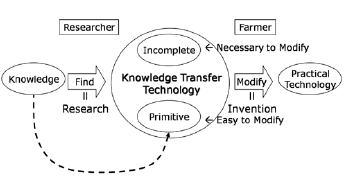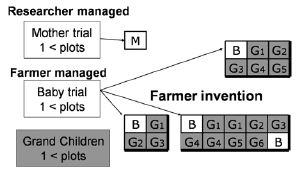Technology development through empowerment of farmers
Description
The farmer-participatory approach is designed to foster voluntary technology development utilizing farmers’ existing broad-based knowledge and skills. However, some problems have been identified with the most commonly applied selection model (technology menu basket, etc.). 1) It tends to be constrained by current conditions, since farmers’ priorities come first. 2) Increased choice causes an increase in load on the researchers. 3) Because the technological choices available act as preconditions, they cannot be used to develop new technology. 4) The farmer’s role is restricted to selection. To overcome these problems, we developed a new technology development technique for the farmer participatoryapproach, which we call the invention model.
The farmer can modify the technology voluntarily and unrestrictedly, without being tied down by priorities, so there is considerable potential to modify it. Knowledge that becomes the nucleus of a new technology is set up as a knowledge transfer technology (technology for knowledge transfer). The farmer obtains practical technology through the execution of the knowledge transfer technology, after which modifications that are based on their own knowledge and ideas can be added (Fig. 1).
In the past it was believed that technology for transfer should be complete. However, in this model, the technology is incomplete, so that the farmer can readily modify it on their own initiative.
One example of the implementation of this method (the “mother, baby, and grandchildren” method) is as follows. The researcher executes the knowledge technology as a model in one plot or more (mother). The farmer imitates this and executes the knowledge technology in their own field (baby). An experimental area, where individual knowledge and ideas can be added, is set up at the same time (grandchildren). Each farmer adjusts the baby and grandchildren’s numbers according to the resources available and the basic idea (Fig. 2). The knowledge technology should be a new idea that is interesting, simple to modify, easy to execute, and designed methodically enough to be able to measure or observe the results.
In the rainfed agriculture project, 10 farmers participated in developing watersaving vegetable cultivation technology. Two mother technologies were modified to generate 44 technologies. Several of these achieved the local average yield using only 5 mm of irrigated water in total under norainfall conditions.
Figure, table
-
Fig. 1. Participatory technology development using knowledge transfer technology. -
Fig. 2. An example of mother-baby trial layout for Invention model technology development.
- Affiliation
-
Japan International Research Center for Agricultural Sciences Crop Production and Environment Division
- Term of research
-
FY2006(FY2006~2010)
- Responsible researcher
-
ODA Masato ( Crop Production and Environment Division )
- ほか
- Publication, etc.
-
Masato Oda, U. Sukchan and J. S. Caldwell (2005): The Invention Model: A New Type of Farmer-Researcher Partnership Created in Developing Water Saving Technologies. JIRCAS W. R. No.47 115-120
Masato Oda, U. Sukchan and J. S. Caldwell (2005): Farmers Begin to Invent Water Saving Cultivation in Northeast Thailand. Proceedings of the 18th International Symposium of the International Farming Systems
Water saving vegetable production method, Thailand: FAO SARD Good Practice Database (http: //www.fao.org/sard/en/init/1574/1846/index.html)
- Japanese PDF
-
2006_seikajouhou_A4_ja_Part11.pdf535.36 KB


